|
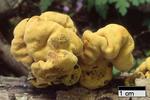
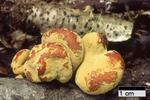
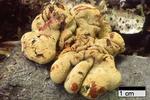
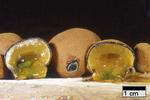
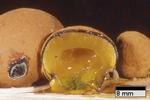
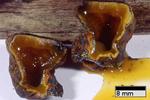
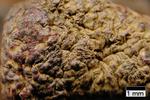
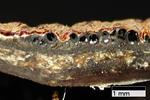
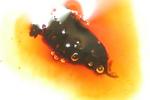
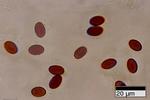

|
Entonaema cinnabarina (Cooke & Massee)
Lloyd
Stromata superficial, pulvinate, folded, irregular to
subglobose, somewhat constricted at the base, soft, shrivelling
upon drying, 18-42 mm diam x 15-32 mm high; surface sienna (8),
rust (39), bay (6) to dark brick (60), eventually blackish, when
immature coated with a pale luteous (11) pruina readily rubbed
off, smooth when fresh, deeply folded when dry. Outer layer a
continuous crust 60-80 µm thick, of orange to orange red
granules with KOH-extractable pigments orange (7); the tissue
enclosing the perithecia 0.45-0.6 mm thick, blackish, replaced by
a thin whitish layer just beneath the outer crust; a gelatinous
layer is present beneath the perithecial layer, luteous (12),
greenish toward the base, soft, 6-1.3 mm thick on fresh material,
blackish, horny, 1-1.5 mm thick on dried material. The centre of
mature stromata is hollow, filled with a luteous liquid with a
striking curry-like odour (reminiscent of fenugreek according to
M. Stadler). This odour is faint, but still perceptible in dried
material.
Perithecia spherical to obovoid, 0.3-0.35 mm diam x
0.4-0.55 mm high.
Ostioles lower than the stromatal surface,
obsolete.
Asci cylindrical, long-stipitate, 110-125 µm
total length x 6.5-9 µm broad, the spore bearing-parts
59-73 µm long, the stipes 55-70 µm long, with a
discoid amyloid apical ring 0.6 µm high x 2-2.4 µm
broad.
Ascospores brown, broadly ellipsoid nearly equilateral,
with broadly rounded ends, with two conspicuous oil drops,
9.5-11.5 x 4.8-6 µm (M = 10.6 x 5.4 µm), with faint
straight germ slit 2/3 spore-length; perispore indehiscent in 10%
KOH. Owing to the presence of oil drops, the faint germ slit is
not seen in water, guessed in KOH or Melzer's reagent, but
clearly seen in PVA-lactophenol.
Anamorph in nature not seen, even on juvenile
stromata. Reported as Nodulisporium-like in culture Stadler et al.,
(2004a)
Habitat: on bark or decorticated wood of branches of
small trunks. Recorded mostly on Fraxinus excelsior, but
also on Acer negundo, Platanus sp. (current study)
Known distribution: Worldwide. Reported from Africa
(Portugese Congo), Australia, Costa Rica, New Caledonia, Sri
Lanka by Rogers (1981),
Bulgaria Læssøe,
(1997), Japan, Philippines and South France by Stadler et al. (2004a).
Specimens examined: FRANCE.
Pyrénées Atlantiques (64): Auterrive,
Ile du Gave d'Oloron, 06 Aug. 1999, FC 665, leg. J. Vivant, det.
FC, on Fraxinus excelsior; same location, 05 Sept.
1999, JF-99200, JF, JFM and C. Girard, on Fraxinus
excelsior and Platanus sp.; same location, 30 Jun.
2004, JF-04112, JF& M. Stadler, on Fraxinus excelsior
(immature).
Notes: Owing to its massive, soft and bright coloured
stromata , E. cinnabarina is a conspicuous species, but
rarely reported from Europe. It is likely to be very rare in
temperate areas, although one can argue it can be confused with a
jelly fungus (Rogers, 1981),
or with a Daldinia.
Entonaema cinnabarina seems to be widespread in tropics
(Rogers, 1981), where it can
be confused with E. globosum Heim and H. liquescens
Möller, two other species sharing same stromatal colours
ranging from yellow to dark orange brown. The former species is
separated from E. cinnabarina on the basis of slightly
smaller ascospores and brighter red granules
(Rogers et al., 1996), the
latter on the basis of sulphur yellow stromata with olivaceous
tones, lacking orange granules
(Rogers, 1981; Rogers,1982; Sihanonth et al., 1998).
Moreover, according to Heim's description, the internal liquid of
E. globosum is said to be odourless by Rogers (1981),
which is contrasting with our observations on E.
cinnabarina.
These three above species appear to be very closely related,
which is confirmed by preliminary HPLC analyses showing they
differ from other species of Entonaema in containing
mitorubrin and derivatives, of which rubiginosin A, a distinctive
compound also present in H. rubiginosum and related
species of Hypoxylon
(Stadler et al., 2004a,
Stadler et al., 2004b)
In addition, on the basis of HPLC results, two specimens of a
fungus belonging to the species complex including the dubious or
invalid names (Rogers, 1981)
Xylaria splendens Berk. & Curtis, E. splendens
(Berk. & Curtis) Lloyd and E. mesenterica Möller
from Japan and Philippines were shown identical to E.
cinnabarina (Stadler et
al., 2004a).
The comparison of the metabolites profiles of E.
cinnabarina, E. globosum and E. liquescens
shows differences in the distribution of mitorubrin and
derivatives peaks, combined with differences in relative amounts
of each compound, but also points out that European specimens of
E. cinnabarina, in addition to mitorubrin, orsellinic acid
and rubiginosin A present in specimens from tropics, contain
mitorubrinol and five other related metabolites
(Stadler et al. 2004a).
|